Compressors, Guns & Lines, Pt. 2
Our April Article Brought Requests for Additional Information. Here’s More on Picking a Compressor, Gun and Lines.
FROM THE AMOUNT of mail and the number of calls I received regarding my garage air line article in the April issue it didn’t take me long to figure out that everyone loved the set-up but that I needed to expand on how to find the right air compressor for a given spray gun.
Since both spray guns and air compressors have specific psi and cfm ratings and requirements, that seems the best place to start, by explaining the difference between psi (pounds per square inch) and cfm (cubic feet per minute).
Understanding PSI and CFM
The tires under your project out in the garage should have about 28 psi of air in each of them. That air isn’t doing anything. It is just sitting there holding the car up. But if I sneak into the garage and cut the valve stem on one of the tires, that 28 psi of air holding up one corner of the car suddenly has movement. The rate of that movement can be calculated and if you charged up the batteries in your calculator and punched a few of the right buttons, you would find that movement of air to be roughly 3.2 cfm before the tire went flat. That’s the difference between psi and cfm. It is the potential for air movement versus actual movement of air.
One Size Compressor… Doesn’t Fit All
Before I go too far, I have to caution you—my intention is to keep things from getting too complicated. I’m not going to try and plumb your production shop with three body technicians, two painters, a broom pusher, and someone with a clean shirt for the customers to yell at. Instead, I’m going to stick with the one-man, one-tool-at a-time shop and try to help you figure out what size air compressor is going to work best with whatever spray gun you select.
Even so, you still may end up with an air compressor that will literally drain down while operating some pneumatic tools, and the DA sander comes to mind. This sander can be a serious air hog and it takes quite a compressor to maintain one of these tools at peak efficiency. However, to my way of thinking, that shouldn’t really be an issue in the one-man, one-tool shop. Most pneumatic tools, including the air-hogging DA sander, will operate at any given psi as long as that psi doesn’t exceed 120, usually the stated maximum psi for most air tools. Even a small compressor can provide enough psi to keep a DA, and most any other air tool, operating for a while. That is, until the compressor completely drains down and the tool stops working from a lack of air. When that happens, you can stop for coffee and give the compressor time to catch up. No harm done.
CFM Ratings Are Crucial for Spray Gun Operation
What I’m getting at is that tools such as the above-mentioned DA sander, or air chisel, or die grinder, and the list goes on, really don’t care about the air compressor’s cfm output. All these tools care about is that there is enough air moving through them to make them work. The spray gun is the only tool in your shop that must have a constant and consistent flow of air going to it in order for it to work correctly.
Don’t be fooled. Your spray gun may look like it is working as the compressor begins to drain down and reduce its cfm output, but you will quickly find that when the gun isn’t working at maximum efficiency you will start to see the spray pattern shrink, the metallics beginning to mottle in your color coats, and orange peel beginning to appear in the clear coats. It’s problems like this that no painter wants to see and is one of the reasons air compressor cfm ratings are so important where operating a spray gun is concerned.
On the other side of this equation are the spray gun manufacturers. They don’t want to see painters having these kinds of problems, either. That’s why they go to the trouble of plainly stating the cfm requirements of their products on the tech sheets and in advertising. They want their spray guns to operate and to be operated at their maximum capabilities. That is to say they want the spray patterns to remain consistent, the metallics to lay right, no mottling and no streaking, and they don’t want orange peel to be a problem.
Of course, there’s that other thing spray gun manufacturers don’t like and that is high VOC (volatile organic compounds) emissions. Spray gun manufacturers prefer to remain in good standing with the federal EPA (Environmental Protection Agency).
What’s the EPA got to do with VOC emissions? Glad you asked. Elevated cfm where spray guns are concerned equals more over spray and more over spray equals more VOCs pumped into the atmosphere. The EPA doesn’t like that and they have brought their wrath to bear both on spray gun manufacturers and on the users of spray guns to slow the emission of VOCs. That is why we are now so concerned with cfm ratings.
Selecting a Spray Gun Compressor
Cfm ratings for spray guns actually came into vogue with the advent of the HVLP (High Volume Low Pressure) spray gun. The idea behind developing this spray gun was to improve upon the efficiency of spray guns while reducing the amount of VOCs introduced into the atmosphere. Sound familiar?
To do that, more paint had to flow through the gun at a reduced psi rating. Simple math dictates that lower air pressures require higher volumes of air to accomplish the task of improved spray gun efficiency. The plan was simple. The results were no less than impressive. HVLP spray guns deliver more paint to the surface, create less over spray, and are doing less damage to the environment than the old conventional-style spray guns ever dreamed of doing. All we, the users of HVLP spray guns, had to do was find air compressors capable of efficiently operating these guns.
So with that thought in mind, let’s look at an air compressor readily available at your local home improvement center (Photo 1). Now, I’m not advocating that you run out and purchase this particular air compressor; I’m just using this one to give you some specifications and provide you with a few working examples.
The unit in Photo 1 is two-stage, rated at 3.2 hp, has a 60-gallon tank, and operates at 240 volts with a maximum psi output rating of 135. This particular unit is rated to put out 10.2 cfm at 90 psi. That’s pretty good and a unit like this would handle just about any pneumatic tool in the shop without completely draining the tank and slowing the tool to a stop.
But we don’t care about the unit’s cfm rating at 90 psi. The HVLP spray guns we use today need from 18 to 28 psi maximum. So our only concern is to find air compressors with cfm ratings below the 30 psi level. The trouble is, I’ve never seen an air compressor with a stated cfm rating at or below 30 psi. Most have stated cfm ratings at 90 psi and at 40 psi, which is somewhat closer to our need of a rating below 30 cfm. This unit is rated at 11.5 cfm at 40 psi. To find a spray gun that will work with this compressor I did a quick check with Eastwood and found they sell a DeVilbiss FLG-648 #34287 (Photo 2; $190), rated at 12.5 cfm at 23 psi, and their own brand of spray gun, the Concours Spray gun #51605 (Photo 3; $250), rated at 4 cfm at 29 psi.
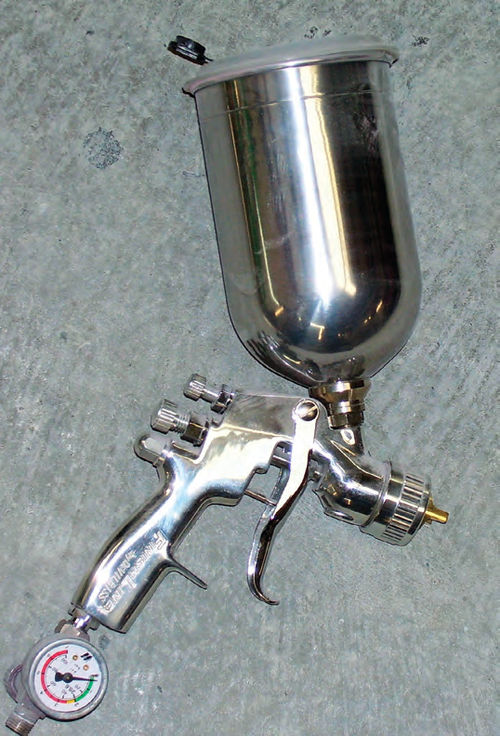
Obviously the Concours gun rated at 4 cfm at 29 psi is a slam dunk to work with this compressor since this unit is cranking out almost three times the needed cfm at 40 psi. Set the psi level at the spray gun inlet to 29 and the available cfm level is going to climb even higher.
Then there is the DeVilbiss FLG-648 rated at 12.5 cfm at 23 psi. We already know the 60-gallon compressor is cranking out 11.5 cfm at 40 psi, so reducing the psi level at the gun inlet to 23 should bump up the available cfm to at least 12.5…Right?
I could bring out a mathematical formula and calculate whether this compressor can handle a spray gun rated at 12.5 cfm at 23 psi but I would need more information than is provided by knowing only these few factors. But, and I’m flying by the seat of my pants here, what I can tell you with a fair amount of certainty is that a spray gun rated at 12.5 cfm at 23 psi should operate just fine with a compressor rated at 11.5 cfm at 40 psi. That’s because I understand that the more you reduce the psi the greater the available cfm. That ratio of change increases exponentially once you fall below the 40 psi output level.
How sure am I? Having survived a few semesters of Physics, Algebra and Calculus Approximations many years ago I am reasonably sure that if the 11.5 cfm at 40 psi compressor were regulated down to 23 psi at the spray gun inlet you would find the cfm rating to be between 13 and 14 cfm at the spray gun inlet. That puts the DeVilbiss FLG 648 just under the wire and safe to use with this particular air compressor.
So let’s make a note of my seat of the pants calculations. If a 60-gallon, 3.2 hp compressor is rated at 11.5 cfm at 40 psi you can expect to see 12 to 13 cfm from 25 to 30 psi, 13 to 14 cfm from 20 to 25 psi, and 15 to 16 cfm from 15 to 20 psi. Mind you, these are rough calculations so don’t yell at me when your situation is slightly off.
Now let’s consider the example of a smaller air compressor. I’ll pick one that is rated at 1.5 hp, is a single-stage, has a 26-gallon tank and produces 6.5 cfm at 40 psi. Will either of the above-mentioned spray guns work with this compressor? Yes, the Eastwood Concours spray gun comes in under the wire at 4 cfm at 29 psi. That’s great since this compressor will crank out 6.5 cfm at 40 psi. Regulated down to 29 psi you should have somewhere between 7 and 8 cfm available at the spray gun inlet.
Will the DeVilbiss gun work? No. This compressor is never going to produce the 11.5 cfm the DeVilbiss needs to operate efficiently.
Single-Stage Vs. Two-Stage
Now let’s back the truck up and talk about the difference between two-stage and single-stage air compressors. You’ll notice that I brought out the two-stage unit first. If you want a very reliable, high-efficiency air compressor that will withstand the rigors of body shop life, you need a two-stage unit.
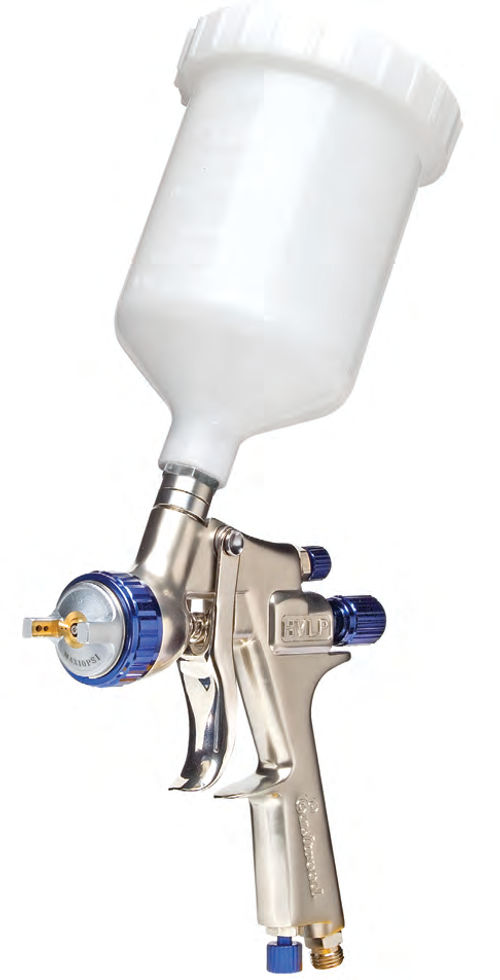
Two-stage means the compressor will have two pistons and that means the unit is capable of producing more cfms per unit of horsepower than a single-stage unit. It also means the unit will produce less heat and less heat equals a longer compressor lifespan.
A single-stage unit, one with a single piston, works harder, produces more heat and is less likely to withstand a body shop’s heavy demands on the unit.
From Guns and Compressors to Air Lines
Sticking with my one-man, one-tool-at a-time shop, air lines are another consideration. What size is best? I featured the Eastwood #51537 Garage Air Kit ($200) in the April article. That system uses 3/8-inch ID plastic tubing to move air from the compressor to three different output manifolds. Is that tubing large enough to provide the needed cfm requirements for a spray gun? Definitely. Remember, we’re dealing with the one-man, one-tool-at-a-time shop. You are not going to be using all three of your manifolds at once.
Of course, if you have plans to grow the size of your shop sometime in the future and work your brother-in law on a regular basis, you might want to consider going to 1/2-inch black pipe. Pipe this size will provide you with the necessary airflow to operate as many as three pneumatic tools at a time, including spray guns. The drawback is that your 60-gallon air compressor may not keep up. Such is the price of expansion.
How Dry My Air
Then there is the issue of delivering clean dry air to the spray gun. If the air moving down your 3/8-inch tubing isn’t clean and dry, your painting is going to be subjected to a variety of issues. What issues? How about fisheye contamination from the oil in the air compressor and moisture dots from condensation in the air lines, just to name a couple.
I don’t care how often you drain the moisture from the air compressor via the petcock on the bottom of the tank; you can’t stop moisture from accumulating in the air lines. Even in a mostly dry climate, like the one I live in, there is moisture in the air. Physics dictates that if you compress air it will heat and dry out. Whatever moisture the now compressed air contained has to go somewhere. That somewhere is to the bottom of the tank where it pools, or out into the air lines where it will be sprayed out the paint nozzle on your spray gun.
To remedy the moisture in the lines problem, you need a filtering system. In the April issue I featured an Eastwood filter #20472 ($200). This unit consists of both an oil filter and a moisture filter. A unit like this is a must to stop oil from the compressor and moisture in the air from entering your air lines.
Again, let me caution you. You will find filtering systems out there that provide for automatic oiling of the tools you use. Do not add this type of unit to your compressed air system if you plan to do any painting. That will just compound the oil-in-the-air line problem. To oil your pneumatic tools, keep a bottle of pneumatic tool oil (hydraulic jack oil) on the bench and oil your tools before each use. That will help keep oil out of your air lines and off of your paint jobs.
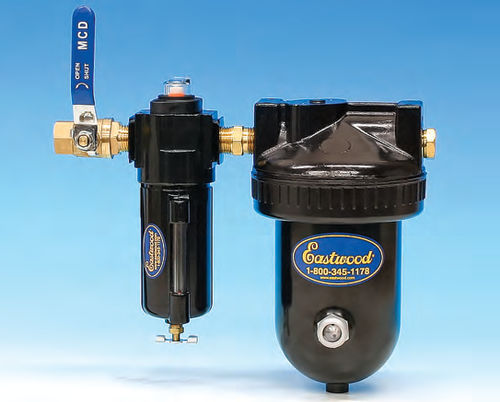
If your plans call for spraying more than one or two cars a year, you should consider the Eastwood #20473 2-Stage Desiccant Dryer System (Photo 4; $260), or the 4-Stage Desiccant System #51508, (Photo 5; $210).
Both of these filtering systems use a desiccant material to soak up moisture in the air lines.
I really like the desiccant systems as the desiccant can be changed as needed and you won’t find a better moisture remover. How do you know when to change the desiccant? Most desiccant filters use a blue desiccant. The blue desiccant turns pink as it loads with moisture.
Enter the LVLP Gun
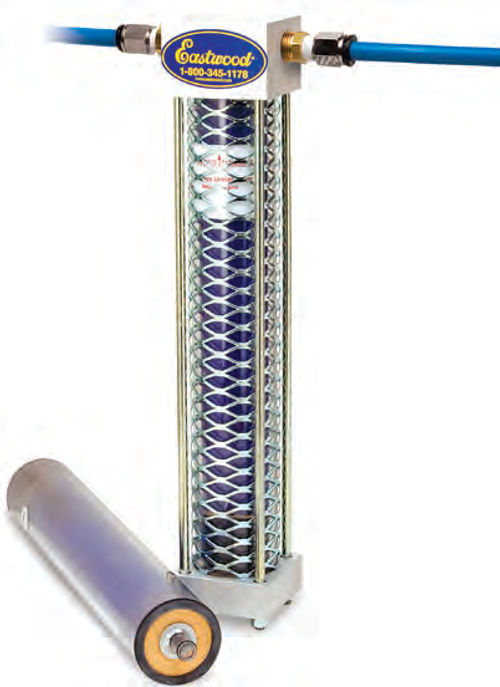
So what’s new on the horizon in the way of spray guns?
How about LVLP (Low Volume Low Pressure) spray guns? The Eastwood Concours gun actually falls into this category with its 4 cfm at 29 psi requirement. Iwata also makes one: LPH-400, as does Optima: Euro 900 and Astro: EVO 4014.
All of these guns are advertised to operate in a range from 4 to 9 cfm at 22 to 25 psi. Yes, that means any of these guns will work with the 60-gallon air compressor example mentioned above. Do they work as well as the HVLP spray guns? I’ve only used the Eastwood Concours gun, but if the others work as well as the Concours, then yes, they do.
Got a question? Send it along.

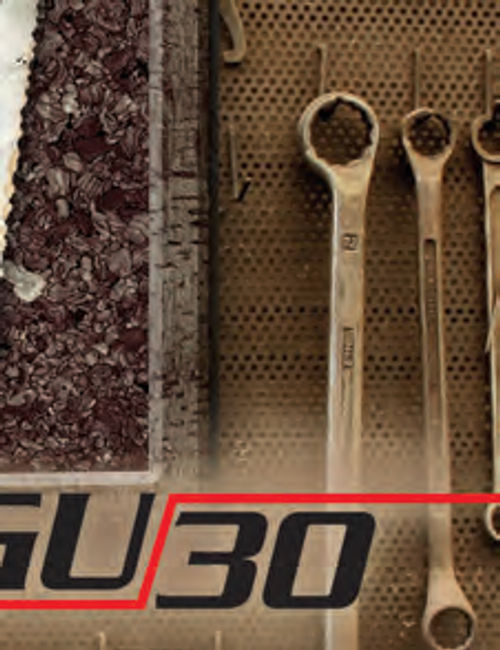
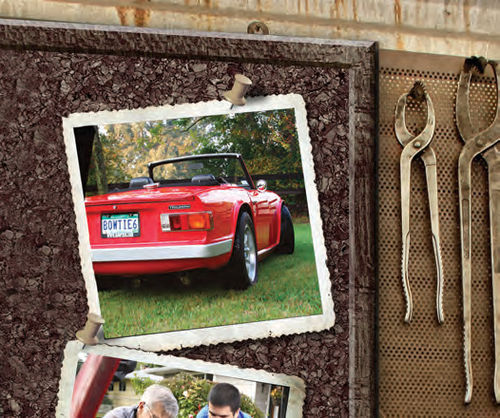
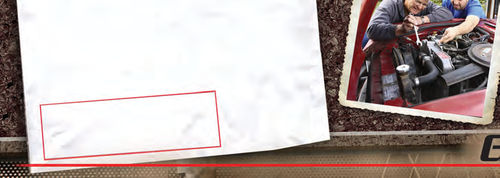
Resources
LPL Body Works
5815 Contented Lane
Amarillo, TX 79109
Paint and body repair DVDs
The Eastwood Company
263 Shoemaker Road
Pottstown, PA 19464
















